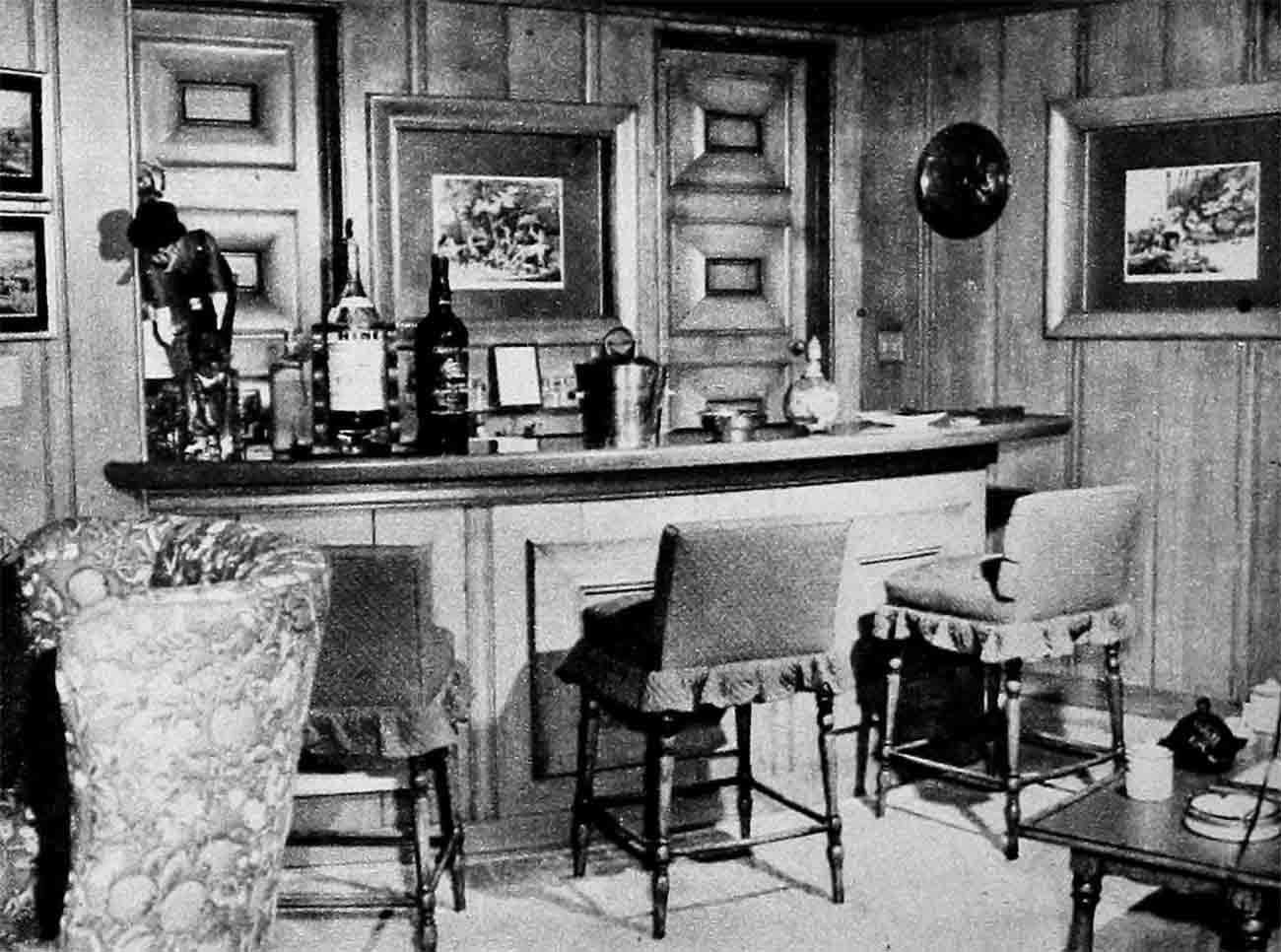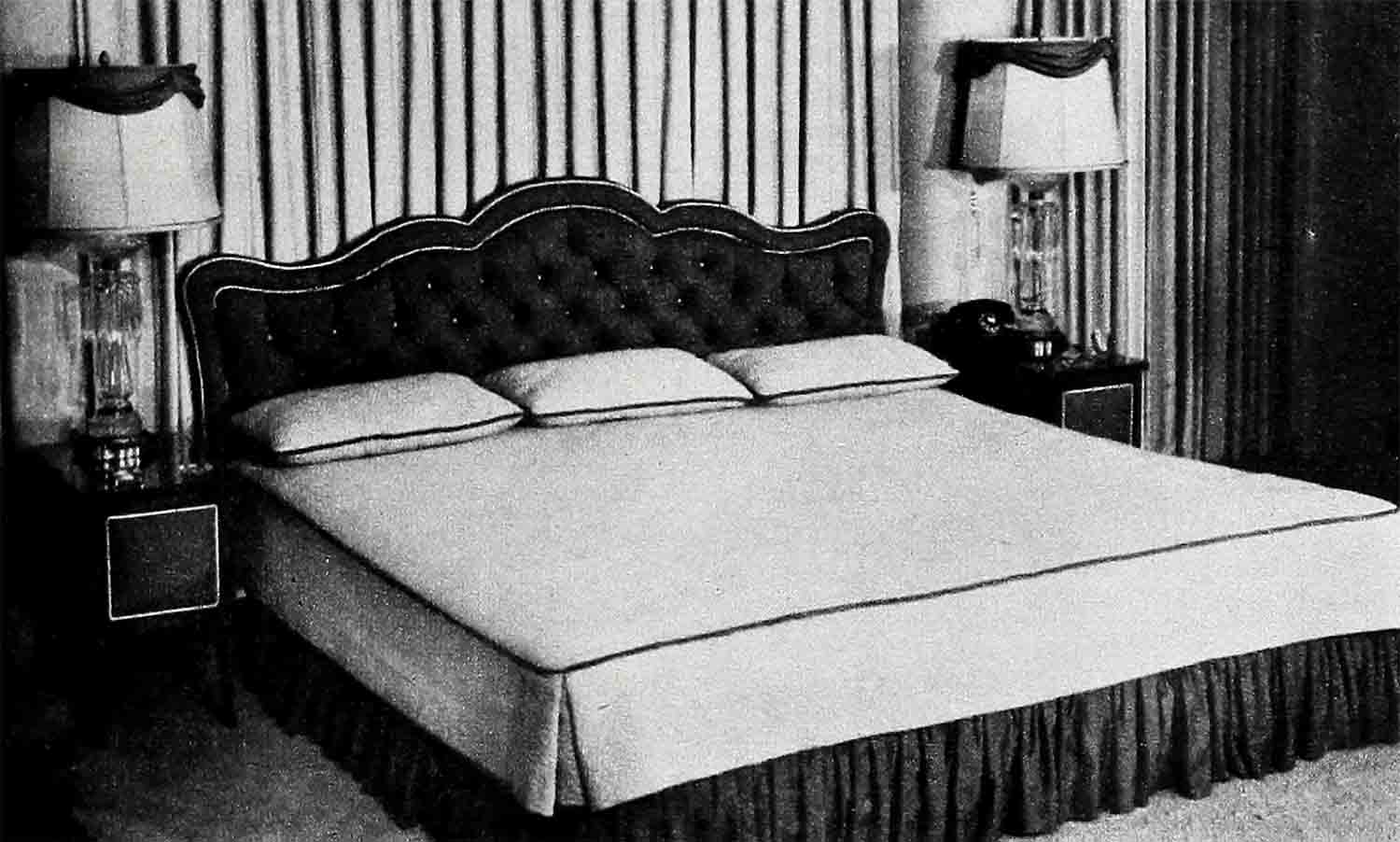House Dutiful—Eleanor Parker
As you drive down spacious Beverly Drive, one of the handsomest streets in Beverly Hills, where the tall Royal palms alternate with the squat date palms to form an exciting pattern, your eye rests happily on a two-storied columned white house, set back amidst green lawns. It’s neither New England nor Southern Colonial, but rather the classic Colonial that is timeless and which could just as well be found, and is occasionally found, in England or Ireland or wherever the Eighteenth Century influence made itself a felt most strongly.

Inside the house you get the same feeling of timelessness. It’s done in soft, dark colors with Eighteenth Century furniture mingling with modern upholstered chairs and couches for solid comfort. It makes a home that is the perfect setting for Eleanor Parker, as serene a beauty as you can possibly find in all Hollywood. But it’s also much more than that, too, because it is, just as much, the correct setting for a dynamic producer, such as Miss Parker’s husband, Bert Freidlob. And it provides plenty of space for the growing family of Mr. and Mrs. Freidlob. They already have one small daughter. By the time you read this, there will be another’ small Freidlob, and their ultimate ambition is to have a whole houseful of children.
As you can see, this is an opulent house, but that is not the reason that I chose it for my little lecture this month. There are scads of opulent homes in Hollywood, with altogether too many of them in doubtful taste. Merely pouring money into individual pieces of furniture won’t give you a perfect room, unless you use it as Miss Parker and Mr. Douglas, her decorator, have done.
My reason for talking about Miss Parker’s house is because it is an example of “grouping.” “Grouping,” I warn you, is going to become increasingly important in our lives at home and for two most amusing reasons. One is television and the other is Canasta, which is beating out bridge socially. If your life is along the lines of the young Freidlobs, if you, too, entertain from six people upward at a time, you must make plans that lets one group of guests cluster around the television, another around the card table, and a third have some place where they can just get away from it all and go in for that old-fashioned pleasure called conversation.

The way the Parker-Freidlob house is planned for all this is masterly.
To begin with, you come into a small, circular hallway, which separates the drawing room at the right, from the dining room at the left. Next, just off the drawing room there is a large playroom. I have never held with the idea of a playroom being designed along the lines that suggests that the adults within it are going to spill liquids all over the floor and loll all over the chairs. Miss Parker’s is not, praise be. But it is, most subtly, divided into fine groupings. Before the bay window that looks out over her garden and swimming pool, there is a permanent card-table set up, big enough to accommodate five or six players, if desired.
Over this table there is a hidden spotlight, which means the light is always right for playing with no danger of knocking over a nearby lamp. The players’ chairs are sturdy and comfortable, with even softer chairs close by for kibitzers. Set in a window-bay, as this card grouping is, it means ten or twelve people could gather round to watch an interesting play, and not get in the way of people seated (a) at the bar in the far corner of the room, (b) before the open fireplace, or (c) at the opposite end of the room, watching a movie on the screen that can be dropped down, cutting off the bar end. The projection room is hidden behind that far wall by pictures on hinges, after the usual Hollywood custom, masking the projection openings, when not in actual use.

I think it’s a wonderful thing that, as in other parts of the country, more and more entertaining is being done at home in Hollywood. Any homemaker, reading this, may not feel up to living as elegantly as Miss Parker does. But it can be seen, nonetheless, how rooms, so planned, make entertaining much easier.
Miss Parker’s extremely restful bedroom, and let me add here that the outstanding characteristic of this house is its restfulness, is done in shades of gray, rose and green, with milk glass lamps picking up the same white accent the white marble fireplace gives the room. The oversized bed has a quilted headboard with a matching spread, and the “touch” that keeps the room from being a bit too conventional is the big, generous sofa at. a far side of the room. This actually unnecessary touch of luxury and comfort gives the room great dash.
Actually, I feel Mr. Tom Douglas, as Miss Parker’s decorator, has used the colors throughout the house for drama, kept the shapes of the chairs, sofas, and tables very simple, which creates this overall mood of both quietude and smartness. The drawing room, for example, has green walls, with raw silk hangings to match at the long bank of windows that occupy the entire outer wall of the room. Before the white marble fireplace are two wing chairs and a sofa in yellow quilted chintz, piped in green. But there are also two raspberry red chairs, there, separated by drum tables in mahogany and the lamps are dark green glass with green shades banded in a darker green velvet.

On the small side tables, the lamp bases are Sheffield, one is a Sheffield sugar bowl planted with Philodendron, with a shade striped in black and chartreuse.
The drawing room and the playroom have been carpeted similarly from baseboard to baseboard with beige carpeting, but while green is used in the playroom, it is used less formally than in the drawing room, which you will instantly realize is as it should be. It has been used in a chintz that combines an apple red. The extra chairs here are in light yellow. The prints on the walls are English sporting scenes, and the small bar has much brass scattered about to give it gaiety.
I offer a couple of minor suggestions, which I trust will not offend Miss Parker and her dynamic husband, and which may, in turn, help you readers if a house of this type is one you believe would suit you.
I should like to see this house made more personal. Take the English hunting prints, for example. They are excellent and inoffensive, but I would actually prefer a picture that was offensive, if interesting, than these highly conventional pictures which are so correct you actually do not see them.
The late President Roosevelt loved ships. His desk was cluttered with models of ships. His walls were hung with ships racing, or being launched, or such things. It gave enormous personality to any room he inhabited, because it reflected him. Miss Parker is one of our most charming ladies, and her husband one of our up-and-coming producers. I hope, as they live more in their house, they will allow it to grow more individual, even if in that way it becomes a little less correct.
Another thing I feel about rooms, as large as their drawing room and living room is that where solid carpeting is used, occasional scatter rugs should also be used, atop the carpet, before some of the couches or chairs, to dramatize their excellent groupings. Try this some time. You’ve no idea how it “warms” a room.
By way of contrast, I’m bringing you a Hollywood house next month that is almost entirely “personality” and much less expense. I hope you will watch for it to see which style suits your design for living best.
THE END
—BY HANS DREIER
It is a quote. PHOTOPLAY MAGAZINE MARCH 1950




